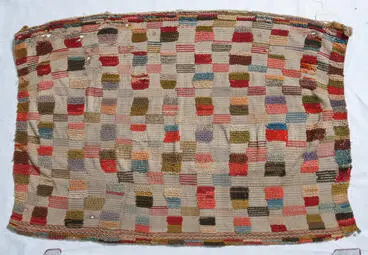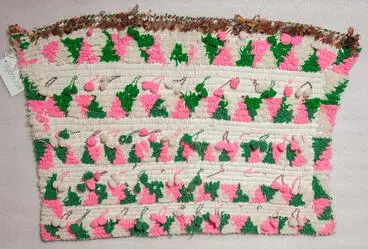Matau rino: Tuia Mātauranga Curiosity Card
A DigitalNZ Story by National Library Services to Schools
An iron fish hook (matau rino) made by Māori in the 19th century.
Matau rino (iron fish hook)
Museum of New Zealand Te Papa Tongarewa
WHAKATAUKĪ
"E kore te matau e rawe ki te moana takai ai, engari anō a uta."
"It is not proper to prepare the hook at sea, rather it should be done on shore."
Matau rino (iron fish hook)
Museum of New Zealand Te Papa Tongarewa
Matau rino (iron fish hook)
Museum of New Zealand Te Papa Tongarewa
Matau rino (iron fish hook)
Museum of New Zealand Te Papa Tongarewa
BACKGROUND
Māori fishing
Fishing was an important activity in Māori life. Fish hooks, (one of the many tools used for fishing) were made of naturally occurring materials such as wood, bone, stone, shell and flax. Fishing lines were made from dressed flax fibre (muka) twisted or plaited into cord.
Increasingly as Europeans began visiting and exploiting New Zealand from the late 1700s, they brought with them materials and technologies unknown to Māori like iron, implements and muskets. Māori were quick to adopt and adapt these new items. For example they continued to make fishhooks but abandoned the use of traditional materials. It was far easier and less labour intensive to fashion fishhooks from bartered items like iron nails.
Although Māori readily adopted new materials like iron to make their fishhooks (and other items like patu), they initially chose to replicate their traditional designs. This changed overtime as traders arrived with European mass-produced hooks. It was far easier to barter for, or purchase, these hooks than fashion them from nails, horseshoes and other metal objects.
Traditional fishing was both a practical and a spiritual activity. There were many ingenious methods and tools, from complex calendars to iridescent lures and woven traps. But fish were also seen as the descendants of Tangaroa, god of the sea. Rituals and talismans were an important way to ensure his favour and protect the bounty of the ocean, lakes and rivers.
When Europeans first arrived in New Zealand, they were amazed at their fishing skills. Captain James Cook, when comparing these skills to those on his ship, wrote in 1773: '[W]e were by no means such expert fishers as them, nor were any of our methods of fishing equal to theirs'.
Source: 'Te hī ika – Māori fishing', URL: http://www.teara.govt.nz/en/te-hi-ika-maori-fishing, (Ministry for Culture and Heritage), (published 12-June-2006)
Te hī ika
Hei ngā rā o mua ka haere te tangata ki te hī ika hei oranga mō te tinana, hei oranga mō te wairua. I a te Māori ngā tikanga me ngā taputapu katoa mō te hī ika - ngā maramataka, ngā maimoa pīataata, ngā tāruke, ngā hīnaki, aha atu. Ahakoa tērā, i mōhio rātou, he tamariki nā Tangaroa ngā ika. Whāia, mā te karakia me ngā tikanga makere ai ngā hua a Tangaroa kei ngā moana, ngā roto, ngā awa, ngā repo, ngā kōawa, arā atu.
Ngā taputapu, ngā tauranga, ngā tikanga hī ika
He maha ngā taputapu mahi ika o Te Moananui-a-Kiwa i auahatia kia hāngai ki te hī ika ki Aotearoa: te kupenga, te aho, te matau, te matira, te pātia, te tāruke, te hīnaki, te pā tuna.
Source: Te hī ika — Ngā taputapu, ngā tauranga, ngā tikanga hī ika', URL: http://www.teara.govt.nz/mi/te-hi-ika, (Ministry for Culture and Heritage), (published 12-June-2006)
Matau rino (iron fish hook)
Museum of New Zealand Te Papa Tongarewa
Matau rino (iron fish hook)
Museum of New Zealand Te Papa Tongarewa
QUICK FACTS
- Maori were quick to begin using the new technology brought by Europeans. They selected the materials and objects they valued most highly and adapted both the function and the form.
- At first, Europeans determined what goods they traded with Maori. They offered cheap items (such as trinkets, cloth, and small iron tools), emphasising their rarity in this country to get as much for them as possible.
- However, Maori quickly took more control in the trading process, raising the prices of their own goods. And as competition among European traders grew, Māori became more discerning about which goods they exchanged with Europeans. In the 1770s, large nails, which could be made into chisels for carving, were the most prized trade items. As century neared its end, iron tools overtook them in popularity.
- Fishing was an important activity in Māori life, as shown by the numerous fish hooks of bone and shell found in some archaeological sites.
- Marsden estimated that Māori food production increased 10 times between 1814 and 1819, due to the introduction of iron tools and the market provided by the missions.
- Hauraki Māori welcomed early European contact because of the new goods it brought – iron tools and new crops in particular. They exchanged food and labour for European goods.
- Hooks varied in size and shape and were made from wood, bone, stone or shell. Sometimes a gorge was used. This was a sharp piece of bone on a line, which caught in a fish’s throat when pulled. To attract kahawai, iridescent pāua shell was used on lures.
- Religious rites and other marks of respect were integral to the practice of fishing. Karakia (incantations) were offered to Tangaroa, god of the sea, and the other gods, inviting them to send an abundance of fish.
- It was common practice to return the first fish that was caught to the sea. Many tribes also had sites on shore where fishermen would place their offerings of fish to Tangaroa, and recite karakia of thanks.
Pātītī
Manatū Taonga, the Ministry for Culture and Heritage
Patu pora (iron hand weapon)
Museum of New Zealand Te Papa Tongarewa
Patiti (hatchet)
Museum of New Zealand Te Papa Tongarewa
OTHER RESOURCES
Cross-cultural exchange between Māori and Europeans — the patu pora is an important example of Māori use of European technology, and highlights Māori ability to adapt to changing circumstances, as well as their ingenuity and creative genius in mixing new materials with old forms.
Māori tools, weapons and other artefacts — the Māori of New Zealand have a rich culture, and this is carried through to their skilfully made and decorated tools.
Perspectives of Māori fishing history and techniques: Ngā āhua me ngā pūrākau me ngā hangarau ika o te Māori — to pre-European Māori, fishing was a significant component of subsistence, and the abundant coastal fish stocks provided a rich and readily available resource.
Māori fishing — an article in Te Pūhikotuhi o Aotearoa (New Zealand Electronic Text Collection).
The largely forgotten history of how early Pākehā mixed with Māori — Fragments of history suggest early interaction between Māori and Pākehā was more balanced than might have been expected.
The lost art of fishing — crafted from wood, bone, stone and flax, Maori fish hooks were masterpieces of design and function, highly effective and able to target desirable species.
The Māori fish hook: Traditional materials, innovative design — traditional Māori fish hooks made using wood, bone, stone, and shell were discarded after the introduction of metals to New Zealand by Europeans, and the knowledge surrounding their design and use was lost.
The traditional Māori ‘internal-barb’ fishhook — following the introduction of metal hooks by Europeans, many traditional fishing practices were abandoned and the mātauranga, or knowledge, surrounding the use of the different hooks was lost.
Traditional Māori fish hooks and trolling lures — article about traditional Māori fish hooks and trolling lures used for fishing.
Tupara (double-barrelled shotgun).
Museum of New Zealand Te Papa Tongarewa
Patiti (hatchet)
Museum of New Zealand Te Papa Tongarewa
Māori Innovation - Adrienne Whitewood
Radio New Zealand
FERTILE QUESTIONS
- Why do people use different materials?
- Ka pēhea rā te awenga a ngā hangarau hou ki ngā tikanga Māori?
- What is the impact of new technology?
- Mā ngā hangarau hou te oranga a te tangata e pai ake ai? He aha ai?
- What makes a technology valuable?
- What is your question?
Pā Kahawai (trolling lure)
Museum of New Zealand Te Papa Tongarewa
Pā kahawai (trolling lure)
Museum of New Zealand Te Papa Tongarewa
Pā kahawai (trolling lure)
Museum of New Zealand Te Papa Tongarewa
ADDITIONAL QUESTIONS
- How does technology cause change?
- What does the sharing of technology reveal about the relationship of Māori and Pākeha?
Traditional Māori fish hooks and trolling lures
Museum of New Zealand Te Papa Tongarewa
Maori innovation hub launched today
Radio New Zealand
TrinityRoots
Manatū Taonga, the Ministry for Culture and Heritage
This story was curated and compiled by Te Puna Mātauranga o Aotearoa | National Library of New Zealand, Services to Schools staff, 2019.




